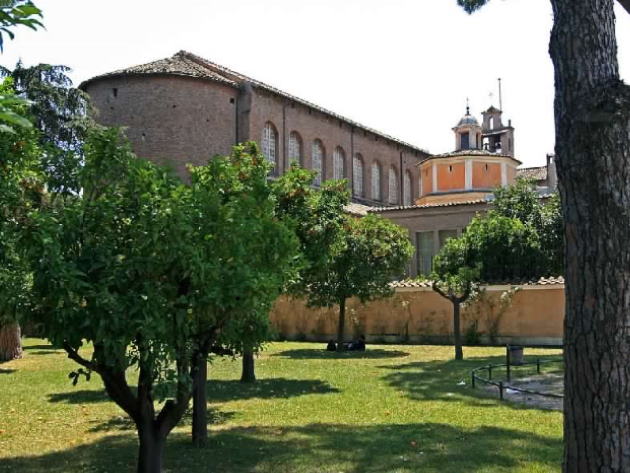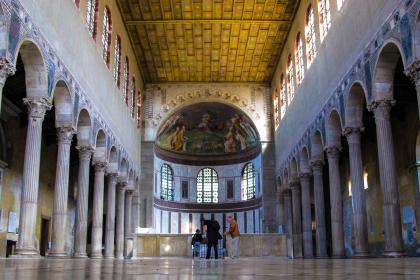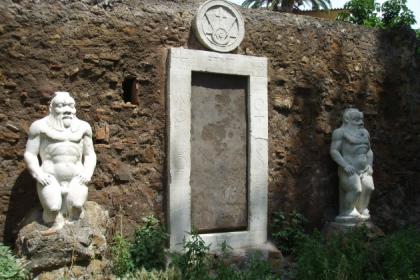
A bit of paradise
An oasis of peace, with a quiet and timeless beauty: the Aventine hill is a piece of paradise and, according to many, its “gem” is the church of Santa Sabina. Bright and harmonious, it was built in the 5th century and is today one of the best preserved early Christian buildings. In 1219 the church was given to Dominic de Guzmán’s friars by Pope Honorius III. The friars have served the church ever since and they now have their headquarters there. Famous residents of the adjacent monastery such as St Thomas Aquinas and Pope St Pius V contributed to increasing its spiritual and artistic charm; St Dominic himself lived in the friary for a period and it’s him who played the leading role in many of the stories regarding the church. The memory of the saint is in fact still very vivid: inside the monastery, for example, we can see his room (which has been converted into a chapel), and in this place the founder of the Order of Preachers met St Francis. A small miracle – first and foremost of botanical longevity – is also linked to the saint and it concerns an orange plant in the courtyard of the cloister. It seems to have been the first to be transplanted in Italy, thanks to a seed brought by Dominic from Spain, his homeland. The orange is visible from the church through a hole in the wall and is considered miraculous because it has continued to bear fruit centuries later. Legend has it that from this tree came the five oranges St Catherine of Siena candied and sent Pope Urban VI in 1379: the pope was famous for his difficult disposition and the little present aimed at showing him that even a bitter fruit could become truly sweet…
The devil is in the details
Some believes hell and heaven are the two sides of the same coin: even in a place with an intense spiritual and religious atmosphere, dark forces can then emerge. Moreover, near Santa Sabina stood the ancient Temple of Juno Regina and the popular rumor claimed that all the churches built on pagan temples were inhabited by obscure presences. If we give credit to the numerous medieval legends, the devil put the life of the religious community to a severe test several times: it is, however, in an apparently insignificant detail that the material evidence of a very close encounter with St Dominic would be hidden. Immediately on the left after the entrance door, in a secluded position, there is a strange black stone with a round shape, polished by time and placed on a short spirally ribbed stone column. The name by which it is known is “Lapis Diaboli”: by tradition, one night, while Dominic was praying as usual on the marble slab that covered the bones of some martyrs, the devil tried in every way to shake his faith and lead him to sin. Without success. Exasperated by such devotion, the devil lost his temper, grabbed a heavy block of black basalt and threw it at him. The blow did not go to sign: the saint was only touched by the stone, which ended up smashing the tombstone and breaking it into several pieces. The holes left by the devil’s claws can still be seen on the stone, which since then was placed in plain sight, almost like a relic, to remind everyone of the power of faith.
The much more prosaic reality
The reassembled marble slab is today in the Schola Cantorum of the church, the enclosure that welcomed the choristers during religious services. Evil tongues claim that it was accidentally broken by the architect Domenico Fontana during the renovation of the church commissioned by Pope Sixtus V in 1587. As for the devil’s stone, it would actually be a “lapis aequipondus”, that is one of the scale-weights used by ancient Romans. Similar examples have survived in other Roman churches, three of them in the church of Santa Maria in Trastevere and one in the church of San Lorenzo fuori le Mura: the holes on the stones were simply used to hold two rings, or two iron hooks, necessary to lift them. Still, even excluding a devil’s intervention, the stones have a sinister and macabre aura. Perhaps because, at the dawn of the Christian era, they were transformed from simple everyday objects into instruments of torture and martyrdom. Also known as “lapis martyrum” (stone of the martyrs), the heaviest stones were tied to the neck of the victims thrown into the water, or to their feet when the body was hung by the wrists and left suspended. An example of the latter macabre modality is in the 16th-century painting by Antonio Tempesta showing the martyrdom of St Primus, exhibited in the church of Santo Stefano Rotondo.
Basilica of Saint Sabina all'Aventino

 Condividi
Condividi
Stories of esoteric and symbolic Rome

 Condividi
Condividi
Spooky Rome, at Halloween or any time
The dark side of Rome's Great Beauty











































